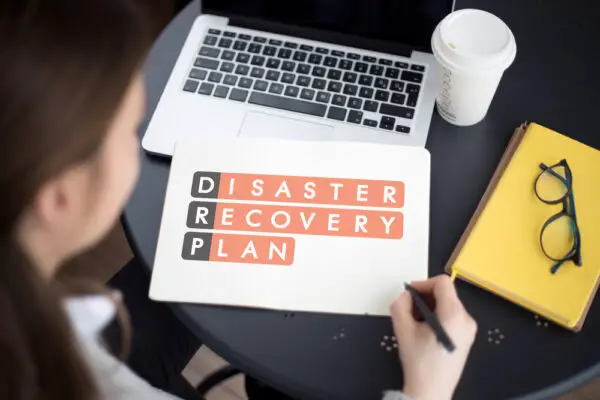Building a disaster recovery plan ensures that the organization can operate and recover quickly during a disaster. Some steps to build a disaster recovery plan:
Risk Assessment: Identify the various disasters that could potentially affect your organization. These could be natural disasters like floods, earthquakes or man-made disasters like cyberattacks or power outages. Assess the potential impact of each disaster on your organization’s operations.
Business Impact Analysis (BIA): Determine the potential effects of a disruption to your organization’s critical business functions. This includes identifying the resources that support these functions and estimating the downtime that can be tolerated before the organization suffers significant damage.
Recovery Strategies: Based on the BIA, develop strategies to recover critical business functions. This could involve setting up an alternate location for operations, arranging for backup resources, or implementing data backup and recovery solutions.
Plan Development: Document the recovery strategies into a formal disaster recovery plan. The plan should include detailed instructions on what to do, who should do it, and how. It should also include contact information for key personnel and emergency services.
Testing and Exercises: Regularly test the disaster recovery plan to ensure it works as expected. This could involve conducting tabletop exercises, walkthroughs, or full-scale drills. Use the results of these tests to refine and improve the plan.
Training and Awareness: Train all employees on the disaster recovery plan so they know what to do during a disaster. Regularly communicate about the plan to ensure that it stays top of mind.
Maintenance: Regularly review and update the disaster recovery plan to account for changes in your organization’s operations, technology, or environment. This should be a living document that evolves with your organization.
The goal of a disaster recovery plan is not just to recover from a disaster but to maintain the continuity of operations and minimize the impact on the organization. It’s about making the organization resilient in the face of adversity.
In today’s fast-paced business environment, organizations face various risks that can disrupt operations and threaten survival. Natural disasters, cyberattacks, power outages, and equipment failures are just a few examples of potential threats that can strike without warning.
Businesses need an effective disaster recovery plan to ensure continuity and protect confidential data. Such a plan outlines the steps to be taken in case of a crisis and guides the organization’s response to minimize the impact of the disaster.
Building a disaster recovery plan is a complex and multi-step process that requires careful planning, analysis, and execution.
This article provides a comprehensive guide to building a disaster recovery plan, covering ten essential steps businesses must follow to ensure they are adequately prepared for any potential disaster.

Identify Critical Areas
To ensure an effective disaster recovery plan, identifying critical areas is crucial. These areas include:
- Products and services.
- Key customers.
- Insurance.
- Property and infrastructure.
- Business continuity strategies.
- Staff training.
- Information backup.
Products and services are the core of any business, and ensuring their continuity during a disaster is crucial.
Key customers are those whose loss could significantly impact the business, and it is important to identify who they are and how to serve them during a disaster best.
Insurance is another critical area, as it can help with financial losses incurred during a disaster.
Property and infrastructure are physical assets that need protection, and business continuity strategies are plans to ensure the business can continue operating during a disaster.
Staff training is essential to ensure everyone knows their role during a disaster, and information backup is necessary to ensure that data is not lost.
Identifying critical areas is the first step towards building an effective disaster recovery plan. By prioritizing resources and efforts, a business can ensure that it can continue operating during a disaster and quickly recover after it.
It is important to regularly review and update these critical areas to ensure that the disaster recovery plan remains relevant and effective.
Create an Emergency Action Plan
The Emergency Action Plan is a crucial component of any comprehensive approach to managing unexpected crises in a business, as it outlines the necessary procedures for responding to emergencies and ensuring the safety of all employees.
It is essential to create a detailed and specific emergency action plan that includes the following:
- Emergency contacts: In the event of a crisis, it is crucial to have a list of emergency contacts readily available. This list should include the contact information for emergency services, key personnel, and any external vendors or contractors that may be needed to assist in the response.
- Procedures: The emergency action plan should outline the specific procedures employees should follow in an emergency. These procedures should be tailored to the type of emergency, including evacuation procedures, first aid procedures, and any specific instructions for dealing with the crisis.
- Evacuation drills: Regular evacuation drills are essential to any emergency action plan. These drills should be conducted to ensure that all employees are familiar with the evacuation procedures and can quickly and safely leave the building in an emergency.
- Emergency kit: The emergency action plan should include a list of essential items that should be included in an emergency kit, such as first aid supplies, flashlights, and emergency food and water. This kit should be easily accessible and regularly maintained to ensure that it is up-to-date and ready for use in an emergency.
An effective emergency action plan, businesses can ensure that they are prepared to respond quickly and effectively to unexpected crises. It is crucial to regularly review and update the plan to ensure that it remains relevant and practical.
Additionally, employees should be trained on the plan’s procedures to ensure they can respond appropriately in an emergency.
Develop Recovery Plan
Creating a roadmap to restore normal business operations after a disruptive event, such as a natural disaster or cyberattack, involves identifying critical areas to consider and developing a comprehensive recovery strategy.
The Recovery Plan is a crucial component of the overall disaster recovery plan.
It involves:
- Assessing the impact of the disaster.
- Identifying recovery contacts.
- Filing insurance claims.
- Developing a marketing strategy.
To begin, a business impact assessment should be conducted to identify which business areas were affected and to what extent. This helps to prioritize recovery efforts and allocate resources appropriately. Recovery contacts should be identified to ensure the right people are notified and involved in the recovery process.
Filing insurance claims is also necessary to ensure the business can recover financially from the disaster. Finally, developing a marketing strategy is essential to regain customer confidence and maintain market share.
Recovery Plan is critical to the success of a disaster recovery plan. It helps to ensure that the business can resume operations as soon as possible, minimizing the impact of the disaster on the business and its customers.
Regular testing and updating of the plan can also help identify improvement areas and ensure that the plan remains effective and relevant.
Choose Recovery Strategies
Selecting appropriate strategies for restoring critical functions is essential for resuming business operations after a disruptive event.
Recovery strategies can include clouds, discs, and tapes, and the choice of strategy depends on various factors such as recovery time, recovery point, file location, and the cost of the solution.
The recovery time is the maximum time to restore critical functions, while the recovery point is the age of files that can be accepted after recovery. To choose the appropriate recovery strategy, it is essential to consider the following:
- Recovery time and recovery point objectives: Determine the maximum time it will take to restore critical functions and the age of the files that can be accepted after recovery.
- Location of files: Know where the files are located and how they are backed up.
- Cost of the solution: Consider the cost of the solution, including hardware and software costs, and the cost of training staff to use the recovery solution.
Once the appropriate recovery strategies have been chosen, testing them to ensure they work as expected is important. Testing the recovery plan helps identify gaps in coverage and provides an opportunity to refine the plan.
It is recommended that critical functions be tested at least once a year and that all staff be trained on their roles and responsibilities during a disaster.
Test and Update Regularly
Regular testing and updating of the chosen strategies are crucial to ensure the preparedness of businesses to overcome any potential disruptive event, instilling confidence in employees and customers alike.
Disaster recovery plans should be tested regularly to identify any gaps or weaknesses in the plan, which can be addressed before an actual disaster occurs. Testing should be conducted in a controlled environment to ensure the plan works effectively in real-world scenarios.
Updating the disaster recovery plan is equally important to ensure that it remains relevant and effective in addressing any new risks that may arise. As businesses evolve and grow, their operational needs and requirements may change, and the disaster recovery plan needs to be updated accordingly.
The plan should be updated systematically and methodically, ensuring all plan elements are reviewed and any necessary changes are made.
Regular testing and updating of the disaster recovery plan are critical to ensure businesses can quickly recover from an unexpected event and minimize the disruption caused.
Conducting regular testing and updating, businesses can remain confident that their disaster recovery plan is up-to-date and can effectively address any potential risk.
Additionally, it demonstrates a commitment to the safety and security of both employees and customers, enhancing the business’s reputation in the long run.
Frequently Asked Questions
What are the different types of disasters that a disaster recovery plan should address?
A disaster recovery plan should address various disasters, including cyberattacks, power outages, equipment failures, and viruses. Preparing for all possible scenarios is crucial to ensure business continuity and protect critical data.
How can cloud-based disaster recovery solutions offer advantages over in-house solutions?
Cloud-based disaster recovery solutions can offer advantages over in-house solutions by providing greater flexibility, scalability, and cost-effectiveness. They also offer faster recovery times and better security, as cloud providers can offer advanced security measures and redundancy.
What control measures should be included in a disaster recovery plan?
Control measures in a disaster recovery plan should include preventive, detective, and corrective measures to minimize risks and facilitate effective recovery.
Planning teams may include executive management, risk management, and team leads. Critical data and risks are important considerations.
Who should be included in the planning team for a disaster recovery plan?
The planning team for a disaster recovery plan may include executive management, risk management, and team leads. Critical data and risks are important considerations, and regular updates are necessary for the plan’s effectiveness.
How often should a disaster recovery plan be updated?
Disaster recovery plans should be regularly reviewed and updated to ensure effectiveness in the face of changing risks. The frequency of updates will depend on the size and complexity of the organization, but an annual review is recommended.

Conclusion
Building a disaster recovery plan is essential for any business to ensure continuity and protect confidential data. It is crucial to consider key concepts such as recovery strategies, risks, and critical data to build an effective disaster recovery plan.
Statistics and examples show that disasters can strike without warning and significantly impact businesses. Cloud-based solutions and digital transformation have also changed the landscape of disaster recovery planning.

Chris Ekai is a Risk Management expert with over 10 years of experience in the field. He has a Master’s(MSc) degree in Risk Management from University of Portsmouth and is a CPA and Finance professional. He currently works as a Content Manager at Risk Publishing, writing about Enterprise Risk Management, Business Continuity Management and Project Management.


